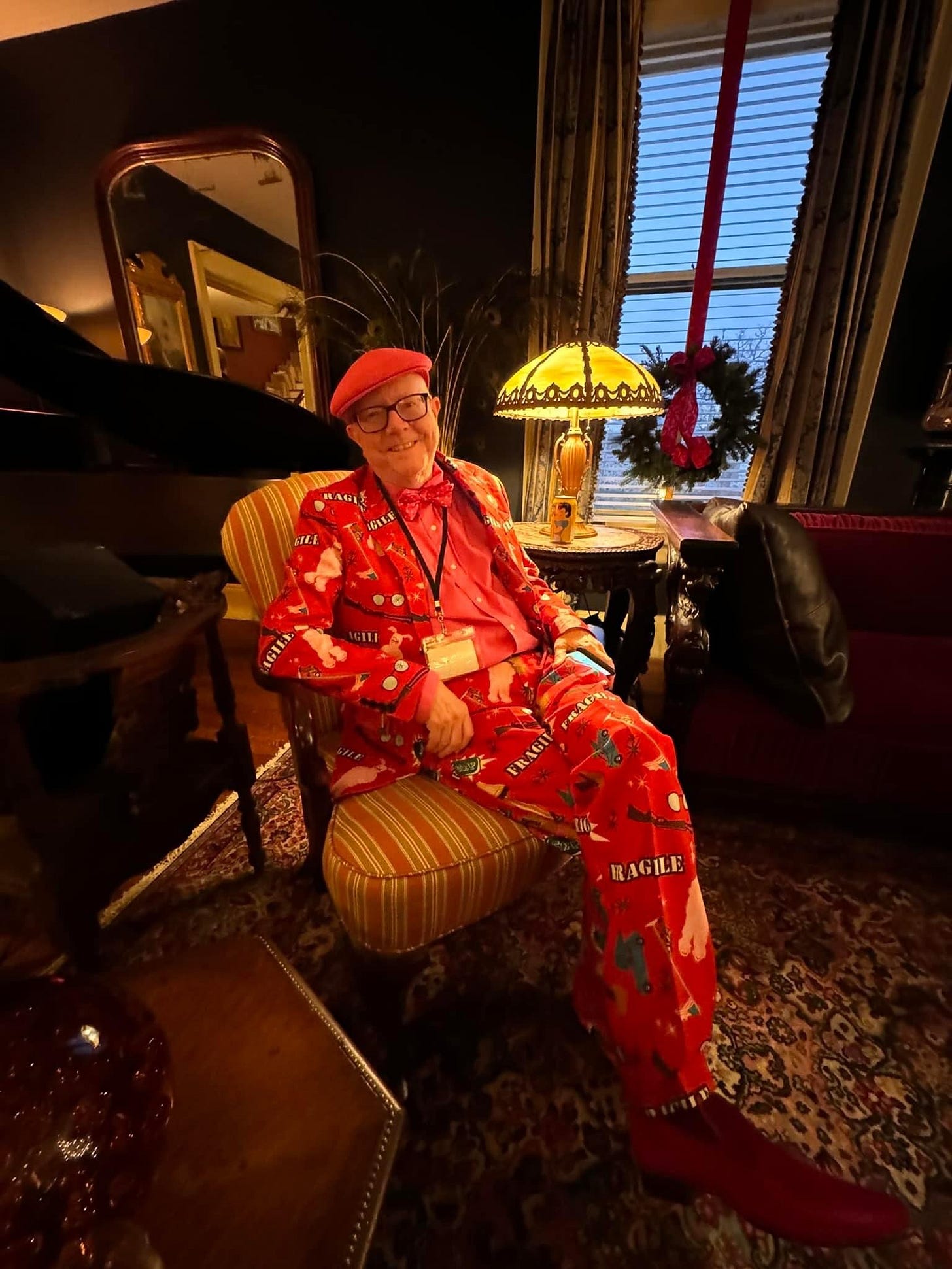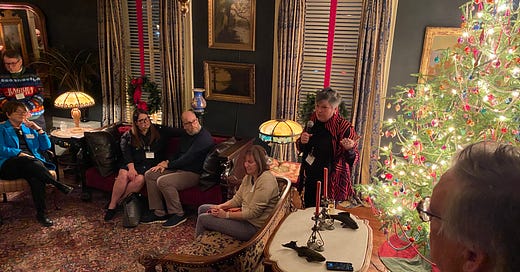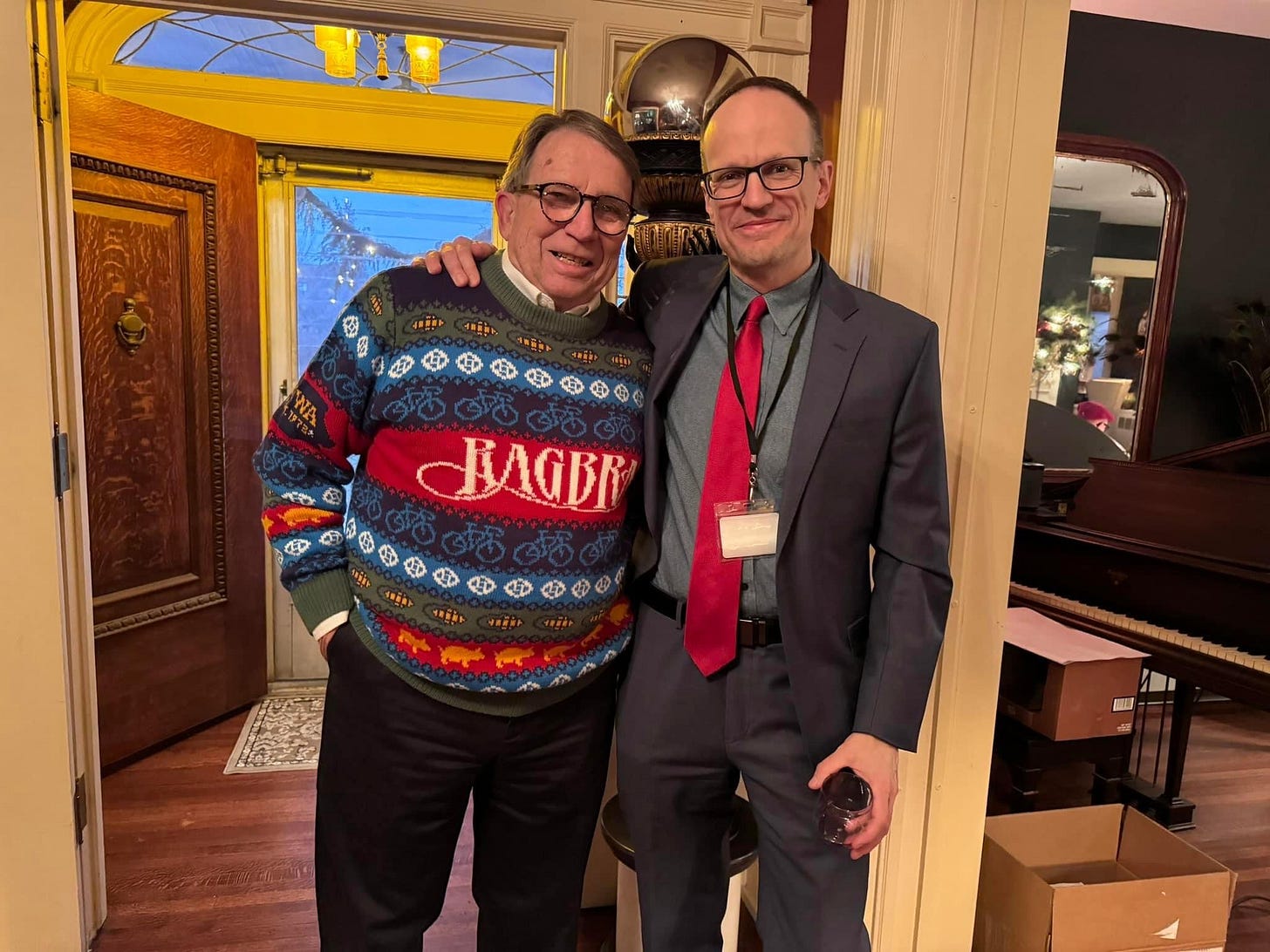20 writers and 150 subscribers toast the holidays (and local journalism) in storied Iowa home
The Iowa Writers' Collaborative waxed poetic and made merry in what had been the governor's mansion.
Daylight fades. So, we gather in holiday celebrations to draw closer and reassure each other with the intangible warm glow of a sense of community and continuity.
No matter your faith or family tradition, this is a primal human urge as autumn slips into winter.
The Iowa Writers’ Collaborative, a unique and heartfelt experiment in local journalism launched about a year and a half ago by Julie Gammack and Richard Gilbert, inaugurated its own holiday gathering this past week with a festive party for paid subscribers. We convened at the Witmer House, 2900 Grand Ave. in Des Moines. Speaking of inaugurations: The house, originally built at the start of the 20th century, was Iowa’s first governor’s mansion from 1949 to 1976. Today, it’s a private residence once again, owned by our gracious host, self-described “old house enthusiast” John Beard. His home still opens its doors to all manner of events, from weddings to funerals.
Twenty collaborative members were on hand—about half of what has become 46 newsletters in this loose affiliation. All of us—professional journalists or writers in some capacity—are independent brands who participate in the collaborative in the spirit of maintaining a statewide sense of identity—a vision of Iowa that’s holistic, empathetic, and humanitarian. The experiment was triggered in part by the urgency surrounding us: The business model for local news is in distress, a contributing factor to the national political polarization that exhausts us.
Casual mingling was the evening’s main agenda. We noshed on potluck treats—I brought my signature peanut brittle—as well as craft cold cuts and other gourmet hors d’oeuvres from Whipporwill Creek Farm, operated by John Hogeland and Beth Hoffman (who writes “In the Dirt” in the collaborative).
The short program began with a masterful poem by Suzanna De Baca titled “The Local Beat.” De Baca, president and CEO of Business Publications, issues a steady stream of original poetry through her “Dispatches from the Heartland.” This poem strikes at the heart of the community journalism that brings us together in the collaborative:
“We look inside our communities, the people, the pain, the joy, opening the doors to our neighbor’s houses and hearts and lives, asking: Who are we? Who will we be tomorrow?”
Robert Leonard, a retired radio broadcaster who focuses on politics and culture with “Deep Midwest,” recited the poem as a massive Christmas tree towered behind him in the corner of the living room.
The late Iowa Gov. Bob Ray, his wife, Billie, and their kids lived at 2900 Grand for eight years, before moving down the street to Terrace Hill.
Gilbert, who worked at Ray’s press secretary in the early ’70s, referred to the house affectionately as his “home away from home” in that era. He also quoted from the 1987 book by Jon Bowermaster, “Governor: An Oral Biography of Robert D. Ray.”
Chuck “Iowa Boy” Offenburger was a newly hired general-assignment reporter for the Des Moines Register in 1972 when he first visited the home to interview the Rays. He admitted to stealing a toothbrush from the governor’s upstairs bathroom. (We all have our skeletons.)
Getting more philosophical, Offenburger characterized the house as “the source of a lot of great moments in Iowa history.” For instance: Ray was renowned for confronting the issues of the day as a humanitarian, especially his rallying of Iowans to help resettle hundreds of refugees from Southeast Asia in communities statewide.
One of Ray’s less momentous memories involving the Witmer House, from the Bowermaster book:
“There’d been a lot of arsons, lots of threats, campus unrest, and we had some special Highway Patrol members guarding our place on Grand Avenue. One morning the help was there—the cook, the guards, the troopers were outside. Billie left the house to take the kids to school, and as she pulled out she passed a guy with a bag over his shoulder walking up the driveway. She didn’t think much about it. Well, I had to walk across the hall from the bedroom to where my suits were hung, and as I crossed the hall I saw someone at the end of the hall, on the second floor. I thought, ‘I wish the help would wait until I went to work.’ It seemed a little early for anybody to be cleaning up. I got dressed and it wasn’t until later that I asked somebody, ‘What are they doing up on the second floor?’ This guy had walked in through all the security, past all the help, past Billie and me, with a bag thrown over his shoulder. Nobody stopped him or said anything to him. Turns out he thought the place was an apartment building and he was putting samples of deodorant by each door.”
The 150 or so guests at the holiday party were issued bags containing gift certificates and fliers—but no deodorant.
John Naughton, my former sports reporter colleague at the Register and author of the newsletter “My Life, in Color,” is a man always decked out in a vibrant suit for every occasion. On this night he was a walking giftwrapped Christmas present, complete with the word “fragile” plastered all over his coat and pants. Speaking to the crowd, Naughton reminisced about his time spent inside the home when—after its turn as the governor’s mansion—it served as headquarters for the Iowa High School Girls Athletic Union.

Circulating throughout the historic mansion, from one conversation to the next, it was easy to feel the continuity across Iowa’s eras—especially from the Rays in the ’70s to today. The holiday spirit in the air I sensed wasn’t obsessed with evaluating whether things today are better or worse. To my mind, every era offers ample reasons for both hope and dread.
This gathering at dusk in December seemed dedicated to wondering whether Iowans can maintain a strong sense of community in a fractured digital age. Can we prioritize and support quality storytelling in the public interest, in the public square? Can we keep asking ourselves the hard questions and dedicate ourselves and our institutions to continuous improvement?
Who are we? Who will we be tomorrow?
As Suzanna says in her elegant verse, the world needs a mirror, and the light tells the true story.
IOWA WRITERS’ COLLABORATIVE
Share these voices with others interested in Iowa and the wide variety of perspectives covered here.






